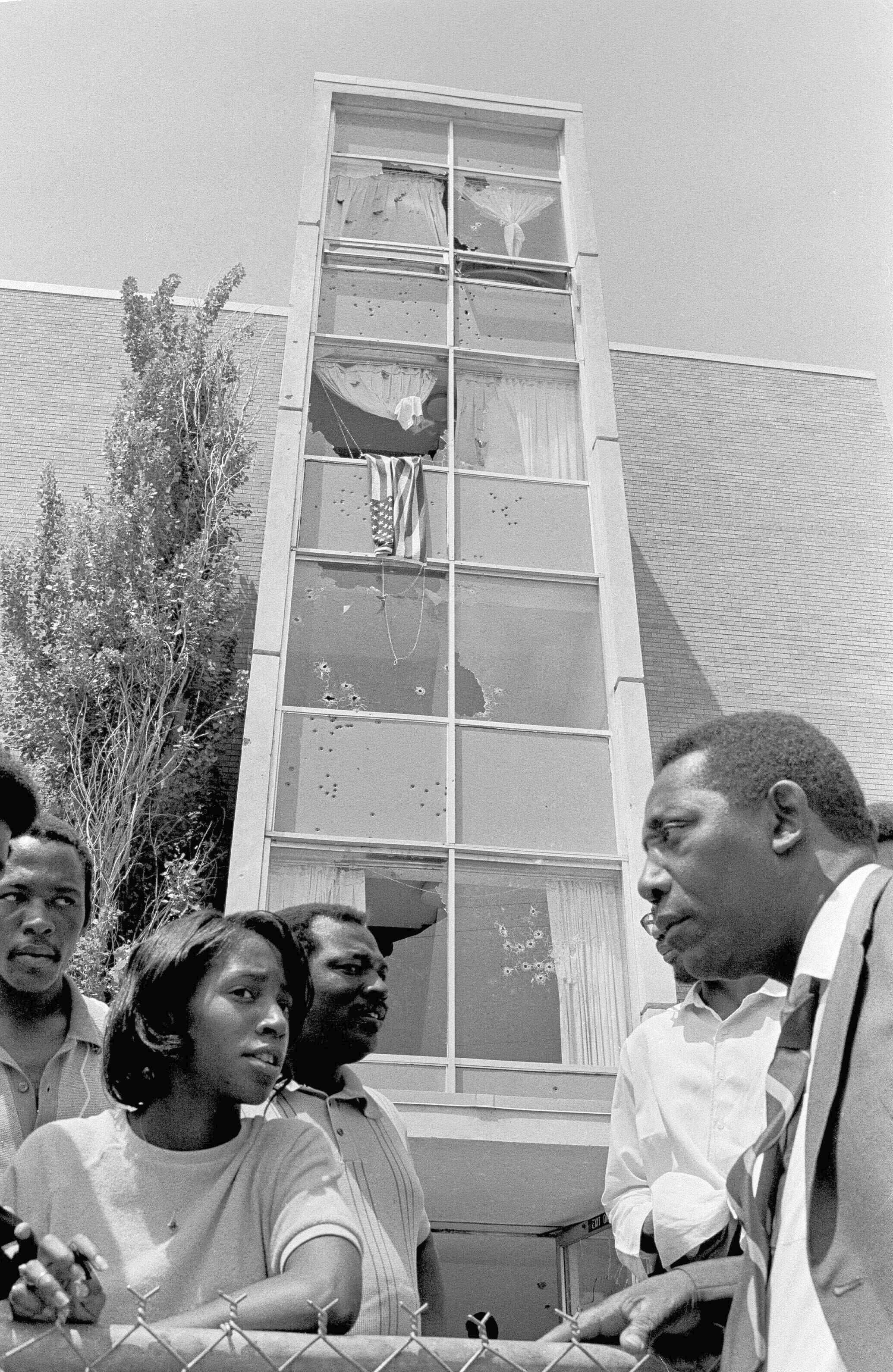55 years to the day after Phillip Lafayette Gibbs and James Earl Green, two young Black men, were killed by police gunfire at Jackson State University, holes from a few of the nearly 500 rounds fired in only half a minute that night still mark the windows and brick walls of F.O. Alexander Hall.
The former street outside of the women’s dormitory became a flash point of racial tension in the 1960’s when White drivers, heading either into or out of downtown Jackson, directed racial epithets at Black students, sometimes threatening to run them over. In response, some students threw rocks at the passing drivers.
But over the late-night hours of May 14 into May 15 of 1970 – only 11 days after the killing of four student protesters at Kent State University by Ohio National Guard soldiers – a force of roughly 75 law enforcement officers, split between Jackson city police and the Mississippi Highway and Safety Patrol, marched deep into the Jackson State College campus to confront demonstrators.
Earlier that night, someone set a dump truck ablaze along the street to temporarily block White motorists from entering campus.
Firefighters soon extinguished the blaze, but under the direction of the infamous former Simpson County Sheriff Lloyd ‘Goon’ Jones, the force of officers – wielding shotguns, personal weapons and a ‘tank’ retrofitted with armor and a machine gun – marched blocks beyond the fire, staging just outside of Alexander Hall, and opened fire.
In just 28 seconds, the force of officers fired nearly 500 rounds into the crowd of onlookers and the building itself, peppering the western wing of the dormitory with bullet holes and injuring a dozen.
Phillip Lafayette Gibbs was there to help his younger sister, a resident of Alexander Hall, move out of her dorm for the summer when he was caught in the gunfire. His wife, then-19 year old Dale Gibbs, had just given birth to their first son, Phillip Jr., and was at home when she received the news of his death.
Two months later she found out she was pregnant with their second son, Demetrius, who would never meet his father.
On the 55th commemoration of Gibbs’ death at the hands of the heavily-militarized riot squad, she spoke only yards from where his body was found after the sudden and extreme barrage of gunfire had ceased.
“I don't want this to be forgotten. I want the story to be told, and I want it to be told accurately. In fact, I want the world to know what happened here on May 14th, early morning of the 15th,” she said.
“His car was packed, and he got caught. So it's hard for me to even look back there, because somewhere back there, his blood is still in the ground, somewhere where he did not have to die. Why? What were they doing so bad that he had to die, that there had to be shooting?”
Wednesday’s memorial ceremony marks the tenth consecutive year that Jackson State’s Margaret Walker Center, an archive and museum, has commemorated the events of that night, now best-known as ‘the tragedy at Jackson State’.
Dr. Robby Luckett, a professor in the department of history, said he began organizing the commemoration to honor both the legacy of James Green and Phillip Gibbs, but also their surviving peers in the class of 1970 – many of whom suffered lasting physical wounds and psychological trauma.
Denise Jones-Gregory, interim president at Jackson State University, spoke passionately about the importance of upholding the two mens’ legacy from a plaza now named in their honor.
“We speak it clearly, we remember it directly, and we continue amplifying this story in honor of the two young lives lost right here on these grounds. They were sons, brothers, classmates, and neighbors. Their names live on, engraved in between markers and monuments and carried with every step along the Gibbs - Green pedestrian walkway. We do not pass these markers in silence but in reverence, ” said Jones-Gregory, just outside of Alexander Hall.
“Yet remembrance is more than a ceremony: it is a call to responsibility. If we are to truly honor the pair affectionately known as Gibbs and Green, we must continue to share their story, our story. We must renew our commitment to justice in how we educate, how we lead, and how we serve. That is how we uphold our legacy. This is how we carry the strength that defines this community.”
Despite several local and federal probes into the shooting, no criminal charges were ever filed in the Gibbs and Green’s killings.
The Fifth Circuit Court of Appeals, typically among the country’s most conservative federal circuit courts, found the fusillade of gunfire that night in 1970 far exceeded an appropriate response, but also ruled their surviving relatives and classmates couldn’t sue for monetary damages because the relevant elected officials and law enforcement officers were protected by a legal doctrine called sovereign immunity.



